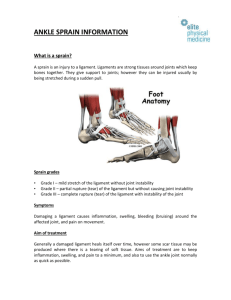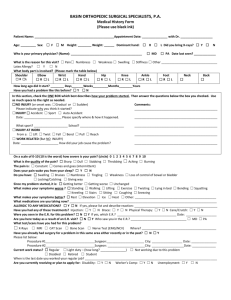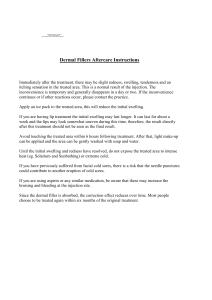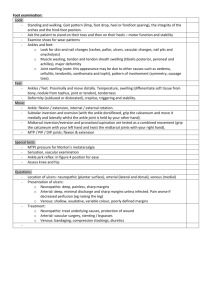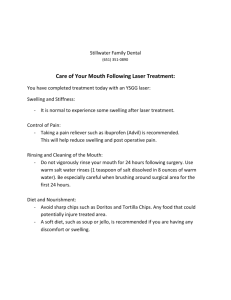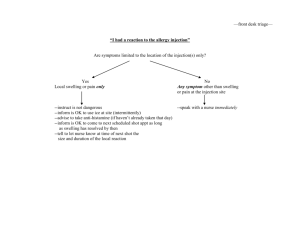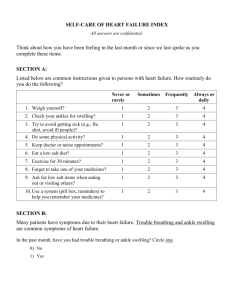Documenting Injuries
advertisement
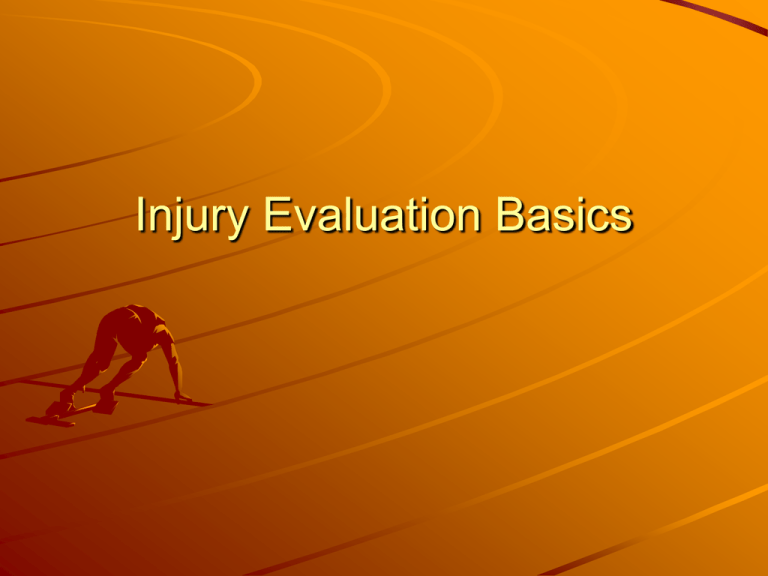
Injury Evaluation Basics The Process Be systematic on your assessment, but do not have a “cookbook” approach. Be calm (it can’t be an emergency for you!) Be confident! Listen to your patient! Do NOT overstep your bounds. – If you don’t know something, do not be hesitant to ask others for assistance. HOPS- History History: Attitude, mental condition, and perceived physical state. – Stated by the athlete. – Primary Complaint – Mechanism of Injury – Characteristics of the Symptoms – Limitations – Past History Purpose: Find out the symptoms. What are the component parts? USE OPEN-ENDED QUESTIONS Depending on the injury, you may have to ask specific questions LISTEN Seven Attributes of a Symptom Location: Quality: Quantity or Severity: Timing: Setting in which it occurs: Remitting or exacerbating factors: Associated Manifestations: Sample History Questions When did problem start? What makes it better? What makes it worse? Is it better or worse in the morning or at night? Is it better or worse w/ breathing, urination, eating, excitement, stress, rest, movements, etc. History of Illness Have you had symptoms like this before? Have you had x-rays, MRIs, or CT scans? Getting better, worse or same? Have you received any treatments? Do you have any family history of chronic disease or health concerns? When Pain is associated! Type of Pain – Acute vs chronic – Local vs referred – Constant vs intermittent – Sharp? – Radiating? – Burning? – Location – Etc.! Purpose: Find out the signs. – Appearance What does it look like?, skin appearance, signs of trauma – Bilateral symmetry – Bleeding – Color/Discoloration – Deformity – Edema/Swelling – Expressions denoting pain RED FLAGS! Constant pain Heart palpitations Fainting Night pain or sweats Difficult or painful swallowing Vision loss Unexpected weight loss Insomnia Excruciating pain Nausea, vomiting Difficult urination Blood in urine Dizziness Chronic fatigue Injury Evaluation Process Symptom: Athletes perception of his or her injury. Sign: Objective, measurable physical finding regarding the individuals condition. HOPS- History Observation Palpation Special tests SOAP- Subjective Objective Assessment Plan. HOPS- Observation and Inspection Observation: Measurable objective signs. – Appearance – Symmetry – General Motor Function – Posture and Gait – Deformity, swelling, discoloration, scars, and general skin condition Begin away from the pain & move towards the injury Pain & Point tenderness Malalignment of joint/bone Crepitus Swelling Tissue temperature & Circulatory status HOPS- Palpation Rule out FX (fracture) Skin temperature Swelling Point tenderness Crepitus Deformity Muscle spasm HOPS- Palpation Cutaneous Sensation (nail bed refill) Pulse Stress Tests – Uniplanar tests designed to assess ROM, muscular strength, or ligament stability Special Tests – Multiplanar tests designed to assess ligament stability and functionality Neurological Tests Stress Tests Active Range of Motion (AROM) Passive ROM (PROM) Resistive ROM (RROM)/Manual Muscle Tests (MMT) Ligament stability – Instability & Endpoints – End feel (Starkey Tables 1-3, 1-4, p. 13) – Relative ligament laxity (Starkey, Table 1-7, p. 15) HOPS- Special Tests Functional Tests – Active Range of Motion (AROM) – Passive Range of Motion (PROM) – Resisted Manual Muscle Testing (RROM) Stress Tests – Ligamentous Instability Tests – Special Tests HOPS- Special Tests Neurologic Tests – Dermatomes – Myotomes – Reflexes – Peripheral Nerve Testing Sport-Specific Functional Testing – Proprioception and Motor Coordination HOPS- Special Tests Sport-Specific Skill Performance – Throw the football, baseball, softball, javelin... – Kick the soccer ball, football, opponent… – Macarena, Cabbage Patch, Mash Potato Special Tests Ligament stability – Instability & Endpoints – End feel (Starkey Tables 1-3, 1-4, p. 13) – Relative ligament laxity (Starkey, Table 1-7, p. 15) Function – – – – – – – Jumping Pivoting Backpedaling Starts Change of direction Throwing & other shoulder activities Core activities Neurological Tests Sensation, Motor function, Reflexes – Dermatomes Two-point Discrimination Test Sharp-Dull Discrimination Test Hot-Cold Discrimination Test – Myotomes Manual Muscle Test (MMT) or Break Test – Reflexes Deep Tendon Reflex Grading (Starkey, Table 1-8, p. 19) On-Field vs. Off-Field Evaluation On-field: quick inspection & evaluation – What is the seriousness of injury? – Is first aid & immobilization needed? – Does the injury need immediate referral? – What is the manner of transportation from the injury site? Off-field: longer and more in depth Finish it! Come to conclusions. Differential diagnosis – List the options For example – What could it be? – Anterior knee pain – Lateral ankle pain Documenting Injuries Writing SOAP Notes IF YOU DON’T DOCUMENT IT, IT DIDN’T HAPPEN Writing a Medical Record The ABCs Accuracy Brevity Clarity Accuracy Never record false information Patient records are legal documents Keep information objective Clarity Meaning should be immediately clear Avoid vague terminology Your handwriting should be legible Brevity State your information concisely but enough information must be presented Use sentence fragments Use abbreviations Writing a Medical Record Punctuation – Avoid hyphens – Semicolon(;) is used to connect two points – Colon (:) is used instead of “is” Correcting Errors – Never erase or white-out – Cross out with one line, write the date, and initial Signature – Use your official title The SOAP Note Organized according to the source the information – – – – S = Subjective O = Objective A = Assessment P = Plan Sometimes preceded by a statement of the problem – Usually the patient’s chief complaint, the diagnosis, or a loss of function. What goes where? Subjective – This information is received from the patient Objective – Results of tests measurements performed and the therapist’s objective observations – Break into separate body parts if necessary Assessment – Probable or Differential Diagnosis SOAP- Subjective History: Attitude, mental condition, and perceived physical state. – Stated by the athlete. – Primary Complaint – Mechanism of Injury – Characteristics of the Symptoms – Limitations – Past History SOAP- Objective: Observation: Measurable objective signs. – Appearance – Symmetry – General Motor Function – Posture and Gait – Deformity, swelling, discoloration, scars, and general skin condition SOAP- Objective Rule out FX (fracture) Cutaneous Sens. Skin temperature Swelling Point tenderness Crepitus Deformity Muscle spasm Pulse SOAP- Objective Functional Tests – Active Range of Motion (AROM) – Passive Range of Motion (PROM) – Resisted Manual Muscle Testing (RROM) Stress Tests – Ligamentous Instability Tests – Special Tests SOAP- Objective Neurologic Tests – Dermatomes – Myotomes – Reflexes – Peripheral Nerve Testing Sport-Specific Functional Testing – Proprioception and Motor Coordination SOAP- Objective Sport-Specific Skill Performance – Throw the football, baseball, softball, javelin... – Kick the soccer ball, football, opponent… – Macarena, Cabbage Patch, Mash Potato SOAP- Assessment Analyze and assess the individual’s status and prognosis Suspected injury Site Damaged Structures Involved Severity of Injury Progress Notes SOAP- Plan 1. Immediate treatment given 2. Frequency and duration of treatments and modalities and evaluation 3. On-going patient education 4. Criteria for discharge/return to play Let’s Practice… Case Study – A 20-year old tennis player was chasing after a deep hit ball. While he was maneuvering to the right, he fell forward and felt a pop in his lateral ankle. He reports today with swelling along the lateral malleolus measuring 12 cm in circumference. He is able to partial weight bear to 75% on the left. He admits that he is fearful of bearing weight on the leg because he feels it will give way. His hip and knee strength is grossly 4+/5. Ankle dorsiflexion and inversion are 3/5, and ankle eversion is 2+/5. His active ankle range of motion is -5o dorsiflexion, 40o plantarflexion, and 5o eversion. Negative tests include Kleiger’s and Talar Tilt (inv and ever). Positive tests include anterior drawer (mild opening) and obvious peroneal tendon subluxation with active inversion. Pedal pulse is normal and dermatomes are normal. He was planning on participating in Regional Finals beginning in two days.


